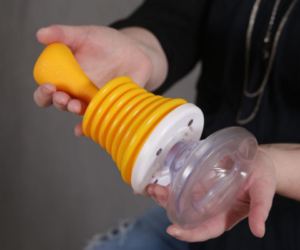Preventing and Helping Choking in Young Children
Infant choking is scary, but it is largely preventable. Infant and young children’s airways
are smaller and easily obstructed. It also takes time for infants to master the ability to
chew and swallow food, and infants may not be able to cough forcefully enough to
dislodge an airway obstruction. As infants and toddlers explore their environments,
they also commonly put objects into their mouths, leading to choking.
Sometimes health conditions increase the risk of choking. Children who have swallowing
disorders, neuromuscular disorders and developmental delays, have a higher risk of choking than other children.
Food is the most common cause of infant choking. However, small objects and certain types
Of behavior during eating, such as eating while distracted, can also cause infant choking.
The following are five ways to prevent infant and toddler choking:
Introducing your infant to solid foods before they have the motor skills to swallow them can lead to choking. Wait until your infant is at least 4 months old to introduce pureed solid foods.
Do not give infants your young children hot dogs, chunks of meat and cheese, grapes, raw vegetables, or fruit chunks, unless they are cut up into very small pieces. Do not give infants or young children hard food, such as seeds, nuts, popcorn and hard candy. Other high-risk foods are peanut butter, marshmallows and chewing gum.
As your child gets older, don’t allow them to play, walk or run while eating. Remind your child to chew and swallow their food before talking. Do not allow your child to throw food in the air and catch it in their mouth or stuff large amounts of food in their mouth.
 Do not allow your young child to play with latex balloons, which pose a hazard when uninflated and broken, small balls, marbles, toys that contain small parts or toys and regularly examine toys to make sure they are in good condition. Check to ensure that toys you are purchasing have not been recalled due to choking hazards.
Do not allow your young child to play with latex balloons, which pose a hazard when uninflated and broken, small balls, marbles, toys that contain small parts or toys and regularly examine toys to make sure they are in good condition. Check to ensure that toys you are purchasing have not been recalled due to choking hazards.
Common household items that might pose a choking hazard include coins, buttons, batteries, dice and pen caps.
It is highly recommended that all new parents take a course in CPR and choking first aid for children. Encourage all who care for your child to do the same. For classes on how to perform CPR on young children, click here.
There are also videos on the Red Cross website on how to perform CPR on infants and young children. The following link will show you how to do the Heimlich Maneuver on infants (link)
At Stepping Stone School, we strictly adhere to all of the preventative measures above. All of our  teachers and administrators are CPR and First-Aid certified which is renewed regularly. Stepping Stone School is the only early care and education provider in the Central Texas area to provide a LifeVac at every campus. All teachers and administrators are trained in the use of this extraordinary upper airway clearing device, which provides the safest and simplest method to
teachers and administrators are CPR and First-Aid certified which is renewed regularly. Stepping Stone School is the only early care and education provider in the Central Texas area to provide a LifeVac at every campus. All teachers and administrators are trained in the use of this extraordinary upper airway clearing device, which provides the safest and simplest method to
save an aspiring person or child. It can be used when the Heimlich Maneuver does not work.
(LifeVac website)
If your child should choke or has trouble breathing, even if you have resolved the choking episode, call your doctor to help make sure your child is really OK.